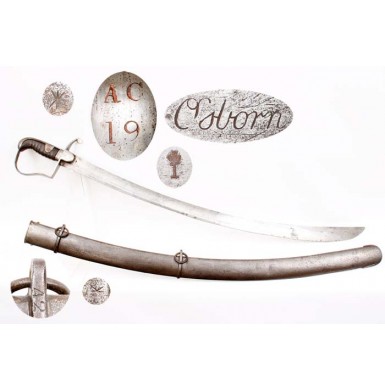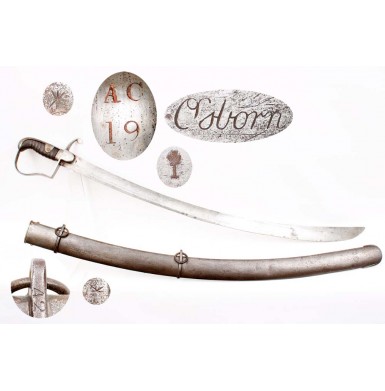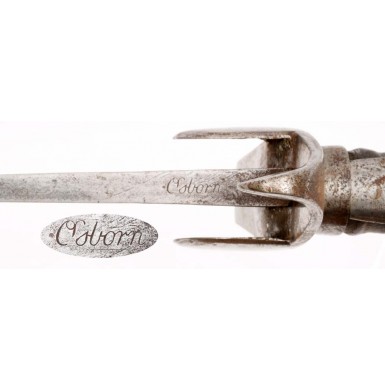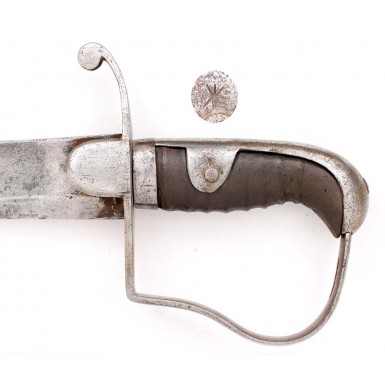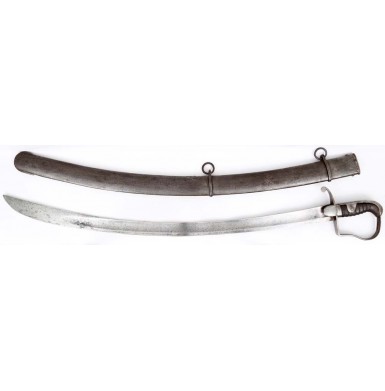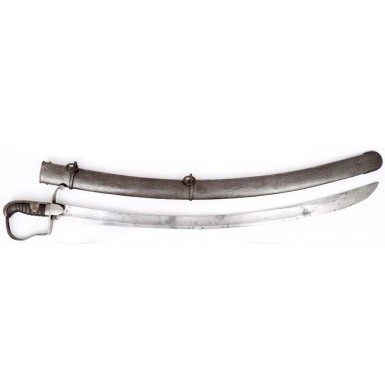British Pattern 1796 Light Cavalry Trooper's Saber
- Product Code: EWSK-1462-SOLD
- Availability: Out Of Stock
-
$1.00
In 1796 the British War Department adopted a newly designed saber for use by the Light Cavalry. This included the Hussars, the Light Dragoons and the Horse (Mounted) Artillery. John Gaspard Le Merchant, a British cavalry officer, designed the saber based upon his military experiences in the field. Le Merchant saw the inadequacies in the British Pattern 1788 cavalry saber design, as well as the failure of the accompanying tactics, while he was serving as a brigade major with the British Cavalry in Flanders, during the Low Countries campaign in the early years of the French Revolutionary Wars (1793-1795). Upon returning to England, he enlisted the aid of English cutler and sword maker Henry Osborn (some references spell the name with an “e” at the end, but Osborn blades are not so marked) and between them was born the Pattern 1796 Light Cavalry Saber. The saber had a curved blade with relatively short, slashing tip, referred to by some as a “hatchet” tip. The blade was typically between 32 ““ and 33” long and had a simple stirrup shaped iron guard with a pair languets on either side of the guard to “trap” an enemy’s blade. The grip was had a grooved wood core, that was wrapped with braided cord and then wrapped with leather, without an exterior wrap of wire as was typical of many sabers of the era. A pair of iron “ears’ extended down from the backstrap on either side of the grip’s center, and a transverse pin reinforced the grip to backstrap attachment; strengthening it and keeping the grip from wobbling or working itself loose from the hilt. Le Merchant’s design was strictly for hacking and slashing, and not for thrusting, as the Pattern 1796 Heavy Cavalry saber was intended. Le Merchant credited the sword designs of the Hungarians, Turks and Moors for his inspiration to create a heavily curved blade that actually got wider near the tip. As the saber was designed and balanced for hacking and slashing at an enemy, it was the last 10” or so of the blade, nearest the tip that saw the most use in combat, and that usually shows the most use on extant examples. This area was often sharpened to a near razor like edge, and period accounts often compare the effect of the 1796 Light Cavalry saber upon its enemy’s to meat being assaulted by a giant slicer! Le Merchant not only designed the saber, but also the accompanying tactics, and taught that the saber should be used to strike at the head and arms of enemy cavalrymen, rather than to thrust at them. British cavalryman George Farmer, who was serving with the 11sth Regiment of Light Dragoons during the Peninsular Campaign against Napoleon, recalled one account of the effectiveness of the P-1796 in combat. During a skirmish with French cavalry on the Guadiana River, Farmer remembered:
“Just then a French officer stooping over the body of one of his countrymen, who dropped the instant on his horse’s neck, delivered a thrust at poor Harry Wilson’s body; and delivered it effectually. I firmly believe that Wilson died on the instant yet, though he felt the sword in its progress, he, with characteristic self-command, kept his eye on the enemy in his front; and, raising himself in his stirrups, let fall upon the Frenchman’s head such a blow, that brass and skull parted before it, and the man’s head was cloven asunder to the chin. It was the most tremendous blow I ever beheld struck; and both he who gave, and his opponent who received it, dropped dead together. The brass helmet was afterwards examined by order of a French officer, who, as well as myself, was astonished at the exploit; and the cut was found to be as clean as if the sword had gone through a turnip, not so much as a dint being left on either side of it.”
The design was so successful and well received that the Prussian Pattern 1811 BL’cher Saber was a nearly direct copy of Le Merchant’s design, and sabers based upon the P-1796 would serve German cavalry well into the 20th century, and even during the First World War! The saber was carried in a heavy iron scabbard that was supported by a pair of mounts with 1 ““ suspension rings. Often the sabers and scabbards that saw service with the British military were rack numbered, and today mixed numbered scabbards and sabers are quite common, as the swords were more likely to be lost on the field than the accompanying scabbards, and a similarly retrieved battlefield pick up usually replaced the lost sword. The Pattern 1796 Light Cavalry saber remained in use with the British cavalry for only a few years after the battle of Waterloo (June 18, 1815), and was officially replaced with the Pattern 1821 Light Cavalry saber, although the effectiveness and the popularity of the P-1796 with the troopers resulted in the saber remaining in service for several decades after its official “replacement”, and even saw service as late as the Crimean War with some units, even though it had been superseded by two different patterns (both the P-1821 and P-1853).
Offered here is a VERY GOOD+, complete and solid example of the British Pattern 1796 Light Cavalry Trooper’s Saber, complete with scabbard. The saber was manufactured by one of its originators, Henry Osborn, and is clearly marked Osborn in script on the spine.
Henry Osborn was a Birmingham based manufacturer who produced a wide variety of military goods. Although best known for his swords, and the P-1796 that he helped design, Osborne was also listed as a Gun maker, silversmith, accouterment maker and hilt maker as well as a sword and dirk cutler. Osborn was born in 1756 and was apparently beginning to serve his apprenticeship to a master sword cutler by 1765, which he appears to have completed around 1784. In 1785 Osborn first appears in the Birmingham directories as a sword cutler, working in Brookhouse Lane, and by 1800 is also operating a manufactory on Bordesley Street, known as the Bordesley Street Mills. In 1802 Osborn opened a retail outlet in London at 82 Pall Mall Street. Around 1806 he partnered with John Gunby and from about 1806-1820 the business operated as Osborn & Gunby. In 1807 the London operation was renamed as well and by 1808 the Pall Mall retail outlet was also listed in the directories as Osborn & Gunby. In 1819 the London retail shop moved to 48 Thames Street, where it would remain until its closure in 1838. The Osborn & Gunby partnership ended between 1820 and 1821 and by 1821 Osborn was again listed as the sole operator of his Birmingham and London establishments. In 1827 Henry Osborn died, and his son Thomas and widow Hannah took over the business, continuing to run it under the Henry Osborn name. In 1838 the London retail location was closed, and the Birmingham location was renamed for Thomas Osborn, under whose guidance it continued until 1849. During his life Henry Osborn was appointed Sword Cutler & Accouterment Maker to His Majesty the King and His Royal Highness the Prince of Wales. He was also a founding member of the Loyal Birmingham Light Horse Volunteers, who served as a yeomanry home guard cavalry regiment during the darkest times of a potential French invasion of England, 1797-1802. Among the other founders of the unit were several notable Birmingham arms makers of the period, including gunmakers & cutlers Thomas Ketland, James Wooley & William Sargant.
The saber is also clearly marked with a royal inspection mark, a small (CROWN) / 1 on the obverse blade, about 1 ““ from the hilt, just in front of the languet. The blade measures just shy of the “regulation” 32 ““-33” length, coming in at about 32 1/8”; well within the allowable margin of error for the time and for handmade blades. Like all P-1796 Light Cavalry Sabers, the blade is widest at the ricasso (about 1 “) and narrows towards the center of the blade (about 1 3/8”), before starting to gently widen for the last 15” to about 1 5/8”. The spine of the blade is .4” thick at the ricasso, and thins evenly to about .1” in thickness approximately 8” from the tip. The blade then narrows even further to only .05” thick at the point, making a very thin, slashing weapon that could no doubt slice meat effectively, as period descriptions noted. The blade has a medium, dull pewter gray patina with scattered speckles of age discoloration, darker surface oxidation and light pinpricking. The obverse shows only one thumb-sized area of moderate pitting, about 8” from the tip. The reverse of the blade shows slightly more speckling, mottling and discoloration a similar thumb sized patch of moderate pitting in about the same general location. The blade shows indications of careful sharpening along the last 10”-12” of the blade, as was common practice during the period. The edge shows a number of small nicks and tiny chips, all indication of real world combat use. The nicks are almost all in the last 12” of the blade, exactly where they should be based upon Le Merchant’s saber doctrine. The iron stirrup hilt is about 4 ““ in length and has a similar dull pewter gray patina as the balance of the sword. The hilt and guard show a thin layer of freckled brown oxidation, that could be easily cleaned off by the new owner, or left along to develop a darker brown patina. The bottom of the guard is clearly engraved with the regimental mark: A C / 19. This probably refers to the Ayrshire Yeomanry Cavalry, who like the Loyal Birmingham Light Horse Volunteers, were raised to help protect England from a potential French invasion during the last years of the 1700s and the first decade of the 1800s. The number 19 is the rack or issue number of the saber. The iron “ear” in the middle of the reverse of the grip has been struck with a pair of opposed Broad Arrows, indicating that the saber was eventually sold out of the British military service. The grip is the typical wood grip with palm swell, which has eight wraps of braided cord over the wood, and is then wrapped with thin leather. The original leather and underlying braided cord wrap are all in place and the leather shows only light wear and some scuffing from carry and use. The hilt and grip are solid and tight and the original blade tang peen at the rear of the bird’s head pommel shows no disruption or signs of ever having been dismounted. The blade to hilt juncture remains tight and there is no wiggle, wobble or slop between the blade, hilt or grip. The saber is 100% original, complete and correct, with no indications of having been repaired or restored at any point in time. An original P-1796 iron scabbard accompanies the sword and appears to have been wit the saber for a very long time. The scabbard is engraved with the rack number 42 on the reverse of the upper mount, so it is probably not the original scabbard to this saber that is numbered 19. However, the swap probably took place in the field during the period of use. Like the reverse grip ear, the upper reverse mount is struck with a pair of opposed Broad Arrows, indicating that the scabbard was sold out of the British military service as well. The iron scabbard is complete and solid and retains both original iron suspension rings as well as the original iron throat. The scabbard has a medium gray-brown oxidized patina, and shows light pitting evenly distributed over all of the iron surfaces. The scabbard if free of any breaks or repairs, and shows only a handful of minor pushes and dings in its surface, with no major dents or creases present.
Overall this is a very nice example of a British Pattern 1796 Light Cavalry Trooper’s Saber, complete with a correct original scabbard that appears to have been with the saber for most of its life. The saber was made by one of the most desirable British sword cutlers of the Napoleonic Era, Henry Osborn, the very man who helped to design it. Even better, the saber can be reasonably dated to between 1796 and 1807, as by that date, Osborn swords were being marked “Osborn & Gunby”, due to the 1806 partnership. The sword is British military inspected, well marked and was also marked when it was sold out of service, along with the scabbard. These sabers saw a significant amount of combat from the last part of the 18th century through the end of the Napoleonic Era. Pattern 1796 Light Cavalry sabers were involved in every major Napoleonic campaign through Waterloo in 1815, and were also carried by the light cavalry regiments serving in America during the War of 1812. The saber was not confined to those conflicts, however, and these swords saw use in every British colony around the world from Canada to India, and on nearly every continent. While these sabers can be found somewhat more easily on the other side of the “pond”, they don’t show up very often in such nice, solid, well marked and complete condition here in the United States. This sword came from an old collection in upstate New York, on the shores of lake Ontario, and may well have some association with the British military movements around the Great Lakes during the War of 1812. This is a very good sword that I am sure you will be quite proud to add to your collection of Napoleonic or War of 1812 militaria.
SOLDTags: British, Pattern, 1796, Light, Cavalry, Troopers, Saber

